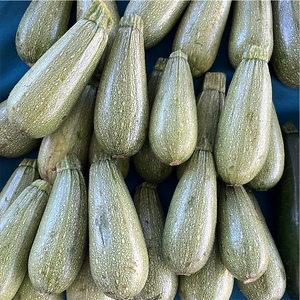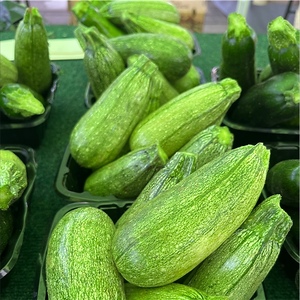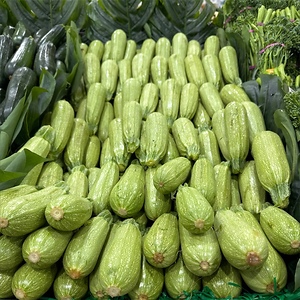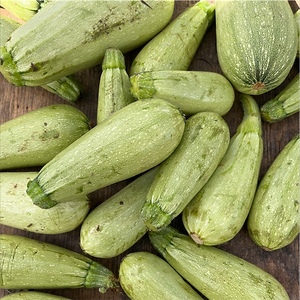


Mexican Grey Squash
Estimated Inventory, lb : 0
Description/Taste
Mexican Grey squash is a relatively small variety, measuring approximately 7.5 to 20 centimeters in length. It closely resembles the shape of a zucchini but is generally stockier in appearance. This variety has a short, cylindrical form that tapers slightly at the neck, becoming broader and heavier toward the rounded bottom of the vegetable, giving it a somewhat pear-shaped appearance. It has a pale, sage-green hue with lighter speckles across its skin. In contrast to the darker green of traditional zucchini, this variety has a distinctly greyer complexion. When fresh, its skin has a shiny, smooth, and tender texture and is easily peeled to reveal a light yellow-white flesh that’s firm yet soft. This nearly seedless variety may have a few small, white seeds in the center of its flesh. Mexican Grey squash is sweeter than the similar-looking zucchini with an overall mild and slightly nutty taste.
Seasons/Availability
Mexican Grey squash is available from summer to mid-fall.
Current Facts
Mexican Grey squash is botanically known as Cucurbita pepo and belongs to the Cucurbitaceae family, which also includes cucumbers, melons, gourds, and pumpkins. This variety is often referred to as Lebanese squash because of its frequent cultivation in that country despite its Mexican origins. It's also called Kousa or Kusa squash, Lubnani squash, Middle Eastern squash, or Grey zucchini. Mexican Grey squash is a summer squash variety, meaning that it’s harvested in warm weather months, has soft skin, and doesn’t store for as long as hard-skinned winter squashes. In Spanish-speaking countries, squash is commonly referred to as either calabaza or calabacitas, the latter being a more specific term for smaller varieties like Mexican Grey squash. In Mexico, calabacitas are often categorized as calabacita bola, which are small and round, and calabacita larga, similar in size to zucchini but with a lighter, slightly greyish hue.
Nutritional Value
Mexican Grey squash is a source of vitamin A, essential for maintaining good vision, supporting immune function, and promoting healthy skin. Its vitamin C content helps boost the immune system, aids in collagen production, and supports tissue repair. The potassium in this vegetable is vital for maintaining healthy blood pressure, proper muscle function, and fluid balance in the body. This variety contains folate, which is crucial for cell division and the formation of DNA, making it particularly important during pregnancy for fetal development. The niacin in Mexican Grey squash plays a key role in energy production, helping to convert food into energy and supporting healthy skin and nerves.
Applications
Mexican Grey squash can be consumed fresh, roasted, fried, pickled, grilled, or steamed. When raw, it can be sliced lengthwise to dip into hummus or ranch and tossed onto a vegetable plate with raw carrots, broccoli, cauliflower, and celery. This variety can be roasted and used in pizza, pasta, casseroles, vegetable bakes, soups, and stews. Mexican Grey squash may also be diced up and incorporated into empanadas, turnovers, tacos, burritos, enchiladas, lasagnas, quiche, stir-fries, and rice bowls. Grated Mexican Grey squash adds moisture to baked good recipes like squash bread, muffins, cake, fritters, and scones, often complemented by flavors like maple syrup, honey, cinnamon, nutmeg, and cardamom. This variety pairs well with olive oil, garlic, onions, tomatoes, roasted chilis, jalapeños, basil, oregano, rosemary, thyme, pumpkin, asparagus, cheese, black beans, garbanzo beans, ground beef, veal, and roasted chicken. Mexican Grey squash should be stored whole, dry, and unwashed in the crisper drawer of the refrigerator, where it will last 1 to 2 weeks.
Ethnic/Cultural Info
The Spanish word calabacitas refers to both squash itself as well as a dish that can be made with Mexican Grey squash, cheese, onions, and tomatoes. In this recipe, the squash is sauteéd with Mexican herbs and spices and then mixed with peppers, corn, and tomatoes. This dish dates back to around 16th-century Spanish colonization in Mexico when Indigenous people would consume it with rice, beans, and tortillas. Calabacitas was enjoyed by colonizers and explorers who then shared it with the various regions of South America where they traveled. As calabacitas was introduced to new countries, the recipe would be altered slightly but the ingredients and method of preparation remained the same.
Geography/History
Mexican Grey squash is a variety that’s commonly grown in both Mexico and the Middle East. It thrives in warm climates with full sun exposure. This cultivated variety must be produced commercially or in home gardens for its specific size, flavor, and appearance. Mexican Grey squash is a descendant of squash varieties that come from modern-day Mexico. The squash species was introduced into Europe by returning explorers in the 16th century. It was then spread across the continent of Europe, eventually making its way to the Mediterranean and Middle Eastern regions. Mexican Grey squash became particularly popular in Lebanon. This variety may be found at specialty stores and farmers’ markets with an emphasis in Mexican or Middle Eastern produce. It’s also sold by many seed growers to be sown in home gardens.
Recipe Ideas
Recipes that include Mexican Grey Squash. One
| Simple Daily Recipes |
|
Pasta with Mexican Squash and Red Bell Pepper |
| Skinnytaste |
|
Skillet Mexican Zucchini |











